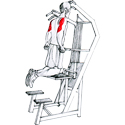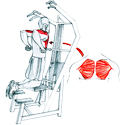-

|
-

|
| Step 1 |
Step 2 |
- Targeted Muscles:
- Chest (pectoralis major and minor)
- Triceps
- Additional Muscles:
- Front shoulders (anterior deltoids)
- On some assisted dip machines, you can adjust the handles to make the grip wider or narrower. The grip you select depends on which muscles you want to concentrate on. A wider grip allows you to focus on working your chest.A narrower grip allows you to focus on working your triceps.
- You can use a dip station to perform non-assisted dips that require you to lift and lower your entire body weight. A dip station is similar to an assisted dip machine but does not have a knee pad or weight stack. Grip the handles of the dip station with your palms facing in. Lift yourself on to the dip station bars, straighten your arms and then bend your knees and across your ankles. Lower and lift your body using the same arm movement as you would on an assisted dip machine. You should take care when performing non-assisted dips if you have lower back problems.
- The assisted dip primarily works your chest and triceps, but also works the front of your shoulders.
- Using the assisted dip machine is one of the best ways to gain strengthin your upper body.
- The assisted dip machine allows you to practice dips without having to lift your entire body weight. When you do not have to lift your entire body weight, you can focus on your proper form.
- Even though the dips are assisted, you should take care when performing this exercise if you have shoulder, elbow or wrist problems.
- Choosing the amount of weight to use on the assisted dip machine may be confusing, since you need to select the opposite of what you should apply to other exercises.
- The assisted dip machine counterbalances your body weight, so you need to choose a heavier weight to make the exercise easier or a lighter weight to make the exercise more difficult.
- Beginners may find that settingthe weight between 60 and 70 percent of their body weight is most effective.
- Do not lock your elbows. Keep your elbows slightly bent at all times.
- Do not shake / shrug the shoulders.
- Do not bend the head forward. Try to keep the head and neck in line with the body.
- Do not lower the body below the position where the upper arms are parallel to the floor.
|











